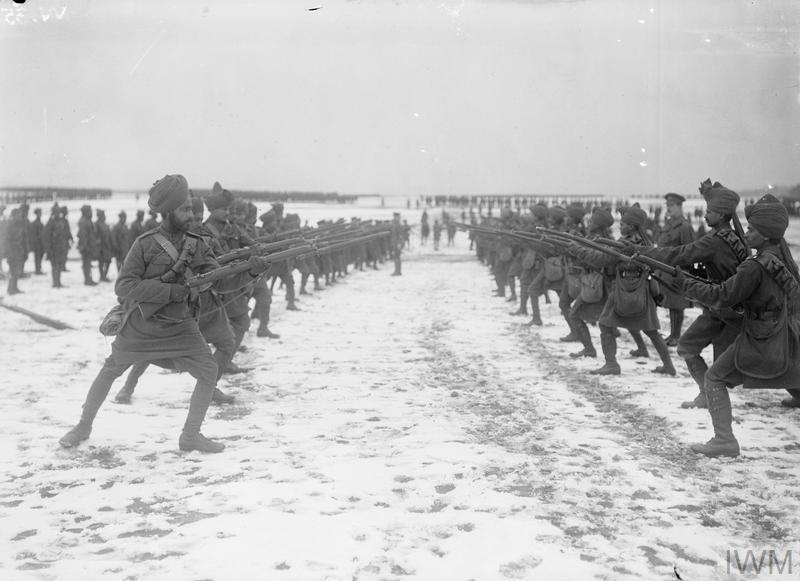
Before World War I, the Indian Army was one of the largest volunteer armies in the world, second only to the British. In 1914, it contained roughly 194,000 Indian soldiers and 46,000 non-combatants together with 77,000 British soldiers.º
To the Western Front
As a well-established force, the Indian Army was amongst the first to be mobilized after war was declared. Within weeks, Indian troops were arriving in Marseilles for deployment on the Western Front. They were woefully ill-prepared in terms of both armaments and winter clothing. Despite this, they were soon in the thick of it at the First Battle of Ypres in Belgium during October and November, 1914.
Traditions & Trenches
Shortages and the conditions of modern warfare were not the only problems that the Indian Army had to face. As Shrabani Basu noted, “….the logistics of taking the Indians to the battlefields of Europe was no mean task. The Indian Army regiments were largely organized along lines of caste and region. The Hindus could not eat food prepared by either the Europeans or the Muslims; some could not even drink water offered by a non-Hindu. The Muslims had their own dietary restrictions; they needed to eat halal meat. The Hindus would not eat beef and the Muslims would not eat pork. There was even a regiment of Brahmins who needed to have a bath before they sat down for their meals, not at all practical in the trenches. To cater to all these requirements, an army of followers had to be taken along with the troops. Cooks were brought in to cater to the different dietary needs. Bhistis or water carriers provided water separately to Hindus and Muslims.”¹
As with any army, non-combatants were critical to its effectiveness as a fighting force. The roles and titles of those commemorated at the Mazargues Commonwealth War Cemetery in Marseilles tell their own tale of the dangers faced by fighters and followers alike. Alongside the fallen Havildars, Naiks, Daffadars, Sowars and Gunners are recorded the Labourers, Followers, Bearers, Firemen and Drivers.²

These forces on the Western Front, known as the Indian Expeditionary Force A, were to be involved in some of the bloodiest fighting in the early part of the war. Over 8,000 were killed and many more wounded. By late 1915, all but the two cavalry divisions were to be redeployed to join the larger part of the Indian Army by then serving in the Middle East.
War Effort
Over the course of the war around 1.3 million Indians volunteered for the Indian Army. The force was made up predominantly of Sikhs, Muslims and Hindus and drawn from modern day India, Pakistan, Bangladesh, Burma and Sri Lanka.† Over a million served overseas, roughly 60% as combatants. By the Armistice, more than 74,000 Indian troops had been killed or were missing, and a similar number wounded.
In addition to the Western Front, the Indian Army was deployed in another six Expeditionary Forces over the course of WWI. They fought in some of the most important theatres of war across the Middle East and Africa.
Post War
Indian Nationalists were hopeful that their participation in the War would lead to ‘Dominion’ status, already secured by the ‘White Commonwealth’ such as Canada, Australia and New Zealand. Despite their presence at the Peace Conference in Paris in 1919, this did not happen. Instead Britain tightened its grip on India and gave the Viceroy increased powers to quell any and all dissent through the ‘Rowlatt Act’ of 1919.³
References & Further Reading
º National Archive
¹ ‘For King & Another Country: Indian Soldiers on the Western Front, 1914-18’, Bloomsbury India, by Shrabani Basu,
² ‘Army ranks and insignia of India‘, Wikipedia
† ‘The Indian Sepoy in the First World War‘ by Santanu Das, British Library
³ ‘Why the Indian Army in WW1 forgotten‘ by Shashi Tharoor, BBC
‘Sepoys in the Trenches: The Indian Corps on the Western Front 1914-15’, The History Press, by Major Gordon Corrigan
‘India and the Western Front‘ by Dr David Omissi, BBC

